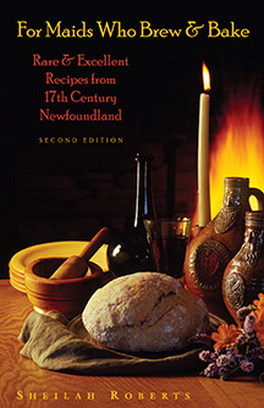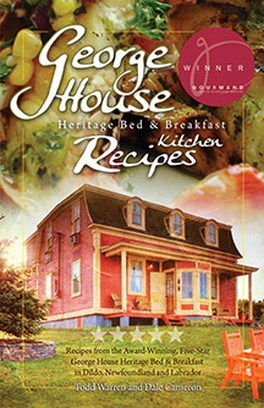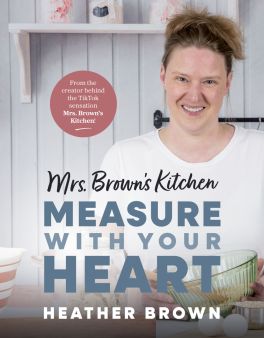Curious cures and delicious recipes from the 17th century are to be found within these pages. With syllabub and loblolly, pottage and spiced bread, this book describes a way of life long gone. It holds a collection of interesting and tasty tidbits with everything from dream interpretation to diet tips: “use a measure of eating that thou mayst live long and if thou wilt be in health, then hold thine handes.” Excerpts from old English manuscripts and Newfoundland letters paint a vivid picture of how Newfoundland’s earliest settlers might have lived. Shortlisted for 2004 Cuisine Canada and the University of Guelph National Culinary Book Awards - Special Interest Food and Beverage Book Award
Egg Dishes
Our poultry have not onely laid egges plentifully, but there are eighteen young chickens, that are a week old, besides others that are a hatching.
(John Guy in a letter from Cupids 1611)
Eggs were an important source of protein in the early days. Because chickens were easy to care for, even a poor family could keep one or two. Eggs were used as a thickening agent in many dishes or eaten on their own. They were not eaten in Lent or on Fridays, and this practice carried on until the middle of the seventeenth century. Traditionally the yolks were for the lords and the whites for the commoners, and in many recipes of the time the whites of the eggs were often discarded. Whites were considered “viscous and cold, and slackens the digestion and doth not engender good health.” In Newfoundland, the colonists ate chicken, duck, goose and seabird eggs. These could be roasted in the embers, poached or fried in lard. Poached eggs were considered best for your health, and fried eggs the worst.
To fry an egge as round as a ball
Take a broad posnet or a deepe frying-panne and a quart or three pints of clarified butter or sweete Suet heate it as hot as you doe to fry Fritters then take a sticke and stirre it till it run round like unto a whirley-pit, then breake an egge into the middle of the whirle and turne it round with our sticke until it bee as hard as soft pocht egge, and the whirling of your suet will make it as round as a bal, then take it up with a slice and put it into a warme pipkin and set it leaning against the fire, for so you may doe as many as you please, and they will keepe hot halfe an hour at the least and yet be soft.
This sounds a bit dangerous, but no doubt the cooks of those days were highly skilled. I wonder how many houses burned down because the cook was trying to round out an egg?
Eggs were often eaten with thin strips of bacon called collops. Hence, the humble beginnings of the bacon and egg breakfast.
Bacon is good for carters and plowmen, the whiche be ever labourynge in the earth or dunge… wherefore I do say that coloppes and egges is as holsome for them, as a talowe candell is good for a horse mouth or a peese of powdred beef is good for a blereyed mare.
(Andrew Boorde, 1542)
To make the best Tansie
First, then for making the best Tansie, you shall take a certain number of Eggs, according to the bigness of your Frying-pan, and break them into a dish, abating ever the white of every third Egge: then with a spoon you shall cleanse away the little white Chicken knots, which stick unto the yolks; then with a little Cream beat them exceedingly together: then take a green Wheat Blades, Violet leaves, Strawberry leaves, Spinage, and Succory, of each a like quantity, and a few Walnut tree buds: chop and beat all these very well, and then strain out the juyce and mixing it with a little more Cream, put it on the Eggs, and stir all well together, then put in a few Crums of bread, fine grated, Cinnamon, Nutmeg, and salt: then put some sweet Butter into the Frying-pan, and so soon as it is dissolved or melted, put in the Tansey and fry it brown without burning and with a dish turn it in the pan as occasion shall serve; then serve it up having strewed good store of Sugar upon it, for to put in sugar before will make it heavey.
Tansy is a bitter herb that was popular in medieval times and up through the seventeenth century. Several types of this plant grow in Newfoundland. If you don’t feel like going into the fields to gather some, try this:
1 cup cooked spinach
¼ cup light cream
2 eggs plus 1 egg yolk at room temperature
⅔ cup fine bread crumbs
⅛ tsp. each of cinnamon and nutmeg
salt to taste
1 tbsp. of oil or butter for frying
Drain the spinach and chop. Beat the eggs and cream together. Combine all ingredients. Heat the oil or butter until quite hot and then pour mixture into pan and reduce heat immediately. Turn when set, and brown on the other side.
~ ~ ~
Perhaps the most colourful legend from seventeenth-century Newfoundland is the one of the Irish princess, Sheila NaGeira. Kidnapped by a Dutch warship while she was on her way to school in France, she was rescued by an English ship captained by Peter Easton, a soon to be pirate. She fell in love with a member of the ship’s crew, a young officer by the name of Gilbert Pike, and the two of them went ashore at the colony of Bristol’s Hope in Newfoundland. It was there that she spent her life and raised a family. She is reputed to have lived to the ripe old age of 105.
The settlers wanted women on the island to keep homes and start families. In 1621 Edward Wynne, the man in charge of the early Ferryland colony, showed that he was definitely in favour of having women here when he said, “Women would bee necessary heere for many respects.”
A must-have book for cooks with a historical interest in Canadian food. Period letters, journal entries and antique manuscripts form a delightful glimpse into the region’s past—all faithfully quoted and wonderfully annotated by the author. This is an impressive work drawn from the annals of history.-- Atlantic Books Today --
For Maids Who Brew & Bake by Sheilah Roberts is a gem. The book is chock full of useful information, anecdotes on different areas of our fine province, old-time recipes and archeological photos. Several people on my gift list will receive this book next Christmas.-- The Newfoundland Herald --
A fascinating hodge-podge of diary and letter excerpts, home medicines, and, yes, recipes . . .-- Northeast Avalon Times --
Deftly and charmingly informative.-- Newfoundland Quarterly --
















